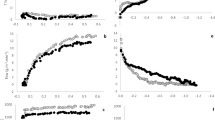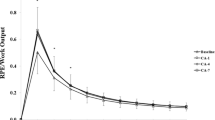Summary
The purpose of this study was to investigate the thermoregulatory mechanisms underlying artificial acclimatization to cold and to compare them with those of naturally acclimatized men. Six white men were cooled, nude, in air at 10°C for 2 h before and after they had been acclimatized by ten daily cold (15°Q baths of 30–60 min followed by rapid rewarming in hot (38–42° C) water, and again 4 months later after acclimatization had decayed. Six control subjects also underwent the same tests, providing an opportunity to discriminate between changes caused by the immersions and those caused by extraneous influences. Acclimatization significantly reduced heat production and heat loss (P < 0.05) but did not change heat debt. The reduced heat production was accompanied by reductions in shivering (P < 0.10) and in cold-induced muscle tenseness; no evidence of nonshivering thermogenesis or active brown fat was found. These findings are attributed to increased tissue insulation, mediated by an enhanced vascular response to cold that did not involve the cutaneous circulation and was probably located in skeletal muscle. Thermal sensation and discomfort did not change, although perceived strain tended to increase (P = 0.08). Acclimatization was accompanied by, but was unrelated to, slower cooling of the finger and toe. The main conclusions, and many specific findings, agree with those of two previous studies made by the same techniques in naturally acclimatized men wintering in Antarctica. Other significant findings included changes — in particular reduced thermoneutral rectal temperature and a delayed onset of shivering — that are commonly regarded as evidence of acclimatization but were in fact unrelated to it as they also occurred in the control group. They are attributed to extraneous influences, in particular the relaxation of heightened arousal (‘first-time effects’) found in the baseline tests.
Similar content being viewed by others
References
Alvey NG, Banfield CF, Baxter RI, Gower JC, Krzanowski WJ, Lane PW, Leech PK, Nelder JA, Payne RW, Phelps KM, Rogers CE, Ross GJS, Simpson HR, Todd AD, Wedderburn RWM, Wilkinson GN (1977) GENSTAT — A general statistical program. Statistics Department, Rothamstead Experimental Station, Harpenden, UK
Astrup A, Bulow J, Madsen J, Christensen NJ (1985) Contribution of BAT and skeletal muscle to thermogenesis induced by ephedrine in man. Am J Pysiol 248 (Endocrinol Metab 11):E507-E515
Beasley FA, Budd GM, Hicks KE, Macpherson RK, Welch JA (1978) Body temperature regulation in emotional hyperthermia (abstract). Proc Aust Physiol Pharmacol See 9:19P
Bittel JHM (1987) Heat debt as an index for cold adaptation in men. J Appl Physiol 62:1627–1634
Borg G, Linderholm H (1967) Perceived exertion and pulse rate during graded exercise in various age groups. Acta Med Scand 472:194–206
Boutelier C, Timbal J, Colin J (1974) Evaluation de la dette thermique a partir des temperatures corporelles lors des immersions en eau froide. Rev Med Aeronaut Spat 50:113–118
Boutelier C, Bougues L, Timbal J (1977) Technique rapide d'acclimatement de l'homme au froid. Med Aeronaut Spat Med Subaquat Hyperbare 16: 172–176
Briese E, Cabanac M (1991) Stress hyperthermia: physiological arguments that it is a fever. Physiol Behav 49:1153–1157
Brotherhood JR, Budd GM, Regnard J, Hendrie AL, Jeffery SE, Lincoln GJ (1986) The physical characteristics of the members during the International Biomedical Expedition to the Antarctic. Eur J Appl Physiol 55:517–523
Budd GM (1962) Acclimatization to cold in Antarctica as shown by rectal temperature response to a standard cold stress. Nature 193:886
Budd GM (1964) General acclimatization to cold in men studied before, during, and after a year in Antarctica. ANARE Report No 70. Antarctic Division, Department of External Affairs, Melbourne
Budd GM (1965) Effects of cold exposure and exercise in a wet, cold Antarctic climate. J Appl Physiol 20:417–422
Budd GM (1974) Physiological research at Australian stations in the Antarctic and Subantarctic. In: Gunderson EKE (ed) Human adaptability to Antarctic conditions. Antarctic Research Series, vol 22. American Geophysical Union, Washington DC, pp 27–54
Budd GM (1989) Ergonomic aspects of cold stress and cold adaptation. Scand J Work Environ Health 15 [Suppl 1]: 15–26
Budd GM, Warhaft N (1966a) Body temperature, shivering, blood pressure and heart rate during a standard cold stress in Australia and Antarctica. J Physiol 186:216–232
Budd GM, Warhaft N (1966b) Cardiovascular and metabolic responses to noradrenaline in man, before and after acclimatization to cold in Antarctica. J Physiol 186:233–242
Budd GM, Hendrie AL, Jeffery SE (1986) Behavioural temperature regulation during a motor-toboggan traverse in Antarctica. Eur J Appl Physiol 55:507–516
Budd GM, Brotherhood JR, Hendrie AL, Jeffery SE (1991) Effects of fitness, fatness, and age on men's responses to wholebody cooling in air. J Appl Physiol 71:2387–2393
Budd GM, Brotherhood JR, Thomas DW, Beasley FA, Hendrie AL, Jeffery SE, Lincoln GJ, Solaga AT (1993) Cardiovascular and metabolic responses to noradrenaline in men acclimatized to cold baths. Eur J Appl Physiol 67:450–456
Cody RP, Smith JK (1987) Applied statistics and the SAS programming language, 2nd edn. North-Holland, New York, pp 139–152
Davis TRA (1963) Acclimatization to cold in man. In: Hardy JD (ed) Temperature — its measurement and control in science and industry, vol. 3; part 3, biology and medicine. Reinhold, New York, pp 443–452
Ducharme MB, Tikuisis P (1991) In vivo conductivity of the human forearm tissues. J Appl Physiol 70:2682–2690
Fox RH, Goldsmith R, Kidd DJ, Lewis HE (1963) Blood flow and other thermoregulatory changes with acclimatization to heat. J Physiol 166:548–562
Gagge AP, Stolwijk JAJ, Hardy JD (1967) Comfort and thermal sensations and associated physiological responses at various ambient temperatures. Environ Res 1:1–20
Glaser EM, Whittow GC (1957) Retention in a warm environment of adaptation to localized cooling. J Physiol 36:98–111
Glickman N, Mitchell HH, Keeton RW, Lambert EH (1967) Shivering and heat production in men exposed to intense cold. J Appl Physiol 22:1–8
Heaton JM (1972) The distribution of brown adipose tissue in the human. J Anat 112:35–39
Henane R, Flandrois R, Charbonnier JP (1977) Increase in sweating sensitivity by endurance conditioning in man. J Appl Physiol 43:822–828
Heroux O, Depocas F, Hart JS (1959) Comparison between seasonal and thermal acclimation in white rats. I. Metabolic and insulative changes. Can J Biochem Physiol 37:473–478
Horvath SM (1972) Man and cold stress. In: Itoh S, Ogata K, Yoshimura H (eds) Advances in climatic physiology. Springer, Berlin Heidelberg New York, pp 172–177
Joy RJT, Matone CJ, Newcomb GW, Bradford WC (1963) Responses of cold-acclimatized men to infused norepinephrine. J Appl Physiol 18:1209–1212
Kluger MJ, O'Reilly B, Shope TR, Vander AJ (1987) Further evidence that stress hyperthermia is a fever. Physiol Behav 39:763–766
Leblanc J (1966) Adaptive mechanisms in humans. Ann NY Acad Sci 134:721–732
Lugg DJ, Rivolier J (1982) The International Biomedical Expedition to the Antarctic (IBEA). In: Harvald B, Hart Hansen JP (eds) Circumpolar health 81. Nordic Council for Arctic Medical Research, Oulu, pp 620–622
Macpherson RK (1959) The effect of fever on temperature regulation in man. Clin Sci 18:281–287
Meehan P (1958) Avenues of heat loss and peripheral circulation. In: Ferrer MI (ed) Cold injury: transactions of the 5th Conference. Macy, New York, pp 291–320
Park YS, Rennie DW, Lee IS, Park YD, Paik KS, Kang DH, Suh DJ, Lee SH, Hong SY, Hong SK (1983) Time course of deacclimatization to cold water immersion in Korean women divers. J Appl Physiol 54:1708–1716
Ramanathan NL (1964) A new weighting system for mean surface temperature of the human body. J Appl Phyiol. 19:531–533
Regnard J, Lecroart JL, Servin A, Renault H, Boutelier C (1984) Evolution des taux de catecholamine plasmatiques chez les membres de l'IBEA (International Biomedical Expedition to the Antarctic) (abstract). J Physiol (Paris) 79:33A
Renbourn ET (1960) Body temperature and pulse rate in boys and young men prior to sporting contests. A study of emotional hyperthermia: with a review of the literature. J Psychosom Res 4:149–175
Rothwell NJ, Stock MJ (1979) A role for brown adipose tissue in diet-induced thermogenesis. Nature 281:31–35
Thauer R (1965) Circulatory adjustments to climatic requirements. In: Hamilton WF (ed) Handbook of physiology. Circulation, section 2, vol 3. American Physiological Society, Washington DC, pp 1921–1966
Tikuisis P, Ducharme MB (1991) Finite-element solution of thermal conductivity of muscle during cold water immersion. J Appl Physiol 70:2673–2681
Weiner JS (1950) Observations on the working ability of Bantu mineworkers with reference to acclimatization to hot humid conditions. Br J Ind Med 7:17–26
Wright HM (1965) Measurement of the cutaneous circulation. J Appl Physiol 20:696–702
Young AJ, Muza SR, Sawka MN, Gonzalez RR, Pandolf KB (1986) Human thermoregulatory responses to cold air are altered by repeated cold water immersion. J Appl Physiol 60:1542–1548
Author information
Authors and Affiliations
Rights and permissions
About this article
Cite this article
Budd, G.M., Brotherhood, J.R., Beasley, F.A. et al. Effects of acclimatization to cold baths on men's responses to whole-body cooling in air. Europ. J. Appl. Physiol. 67, 438–449 (1993). https://doi.org/10.1007/BF00376461
Accepted:
Issue Date:
DOI: https://doi.org/10.1007/BF00376461




